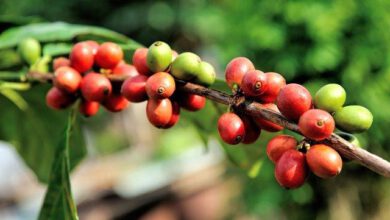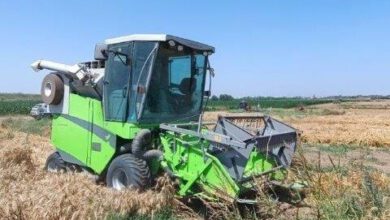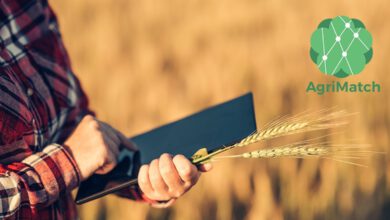Improving fertilization efficiency leads to increased yields
The Galilee boasts fruit quality of orchards due to improved fertilization efficiency

martin goldway, raffi a. stern, doron schneider, amir raz and annat zisovich, migal galilee research institute, and the department of biotechnology, faculty of life sciences, tel-hai college 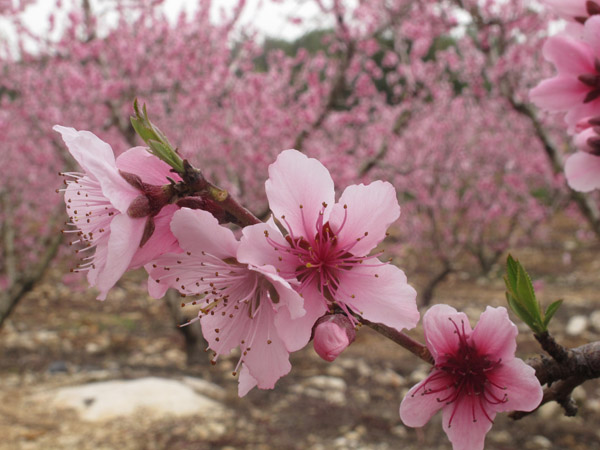
the galilee is the main fruit-producing region in israel. most of the varieties grown there are of the botanical family rosaceae, namely: apple, pear, apricot, plum, cherry, peach, loquat and almond. although the flowers of these fruit trees have both male (pollen) and female (pistil) components, they are self-incompatible-the flower does not fertilize itself. hence, fertilization is achieved by cross-pollination with another cultivar.
despite the excellent standards of the israeli farmer, a comparison to the same cultivars grown in other regions of the world often shows lower yields and smaller fruits in israel. since these fruit trees originate from temperate climates, research is focusing on the tree features that are most affected by the suboptimal mediterranean climate. our group is investigating fertilization and pollination aspects as they relate to yield deficiencies.
because of the dependence on cross-pollination, orchards contain a least two cultivars that flower synchronously and are genetically compatible. self-incompatibility is determined by an rnase-mediated mechanism which is carried by the s-locus. in addition to the s-rnase, the s-locus contains a few sfb genes that hold an f-box motif which are a component of the e3 ligase of the ubiquitin proteasome system. this system, which targets proteins for degradation, was identified by the israelis hershko and ciechanover, for which they received the nobel prize.
the basic model for the rnase-mediated self-incompatibility system proposes that s-rnase is secreted from the style cells and enters the pollen tube. the rnase’s cytotoxicity (degrading the po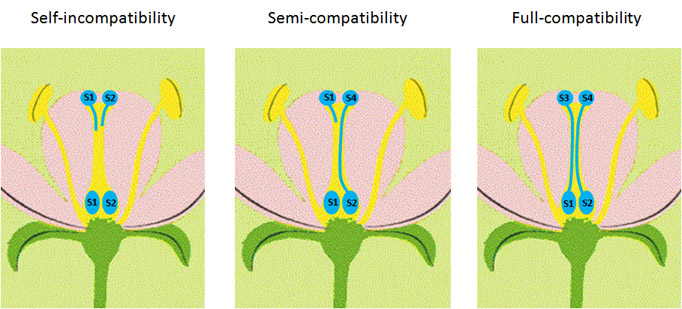 llen’s rna) halts pollen growth and fertilization is prevented. however, in cross-fertilization, the s-rnase is recognized by the sfb protein, leading to its degradation; as a result, fertilization occurs. the rnase-mediated self-incompatibility fertilization system is also being studied in the botanical families solanaceae and plantaginaceae. however, the process in rosaceae is still not fully understood.
llen’s rna) halts pollen growth and fertilization is prevented. however, in cross-fertilization, the s-rnase is recognized by the sfb protein, leading to its degradation; as a result, fertilization occurs. the rnase-mediated self-incompatibility fertilization system is also being studied in the botanical families solanaceae and plantaginaceae. however, the process in rosaceae is still not fully understood.
the s-rnase gene is exceptional in that it comprises hundreds of alleles (genetic forms), tens of them per species. thus, most cultivars differ in their content of s-rnase alleles and this variation enables their molecular typing. full genetic compatibility occurs when the cultivars differ in both of their s-loci, semi-compatibility when they differ in one of their two s-loci, and full incompatibility when both cultivars carry the same s-genotype (figure 1).
to determine if the level of compatibility affects yield, our group analyzed all of the apple, pear, plum, apricot and loquat cultivars grown in israel. we learned that semi-compatibility is a significant reason behind the reduced yield. for example: the apple variety starking planted adjacent to the semi-compatible variety jonathan produced 30% lower yield than when planted adjacent to the fully compatible variety golden delicious.
similarly, ‘spadona’, the main pear cultivar grown in israel, has lower yields than in italy, and it was found to be semi-compatible with the three cultivars that serve as its pollen donors.jpg) : ‘coscia’, ‘gentil’ and ‘spadochina’ (figure 2).
: ‘coscia’, ‘gentil’ and ‘spadochina’ (figure 2).
although both fully and semi-compatible cultivars set fruit, in the latter, half of the pollen is bound to be rejected; in fully compatible cultivars, all of the pollen is accepted. since the israeli spring is characterized by significant changes in temperature between hot and cold days, the conditions for fertilization are usually unfavorable. therefore, full compatibility would confer higher fruit set and yield in the mediterranean climate. moreover, apple and pear fruit can contain up to 10 seeds (since the flower holds 10 ovules), and their fruits tend to be larger and with a fuller form as the number of seeds increases. high-quality, large fruit garner higher prices.
accordingly, the apple variety jonathan was replaced by cultivars that are fully compatible with ‘starking’, and the new pear cultivars being examined for introduction are being selected for their full compatibility with ‘spadona’. the importance of full s-compatibility in regions with suboptimal conditions for fertilization has been acknowledged. in israel, new orchards are designed to take into consideration their genetic compatibility and all newly bred cultivars are routinely s-genotyped (figure 3). in fact, this has become a generally accepted notion worldwide. for example, our group and research teams in most of the leading pear-growing countries have collaborated on s-genotyping most of the world’s pear cultivars and the data are available for the benefit of the world pear community.
this study is an example of basic research that meets agricultural needs, and exhibits a case in which knowledge acquisition is leading to increased yield and income with no need for any monetary investment.
need for any monetary investment.
the research was funded by grants from the jca charitable foundation and the israeli ministries of agriculture and of industry and trade.
figure legends
1) a) schematic description of levels of compatibility between pollen and pistil in the s-rnase-mediated self-incompatibility system (see text for explanation). b) a peach flower
2) s-genotypes of the four main pear varieties in israel. ‘spadona’ is semi-compatible with each of the three other cultivars.
3) compatibility levels between apricot cultivars grown in israel.

